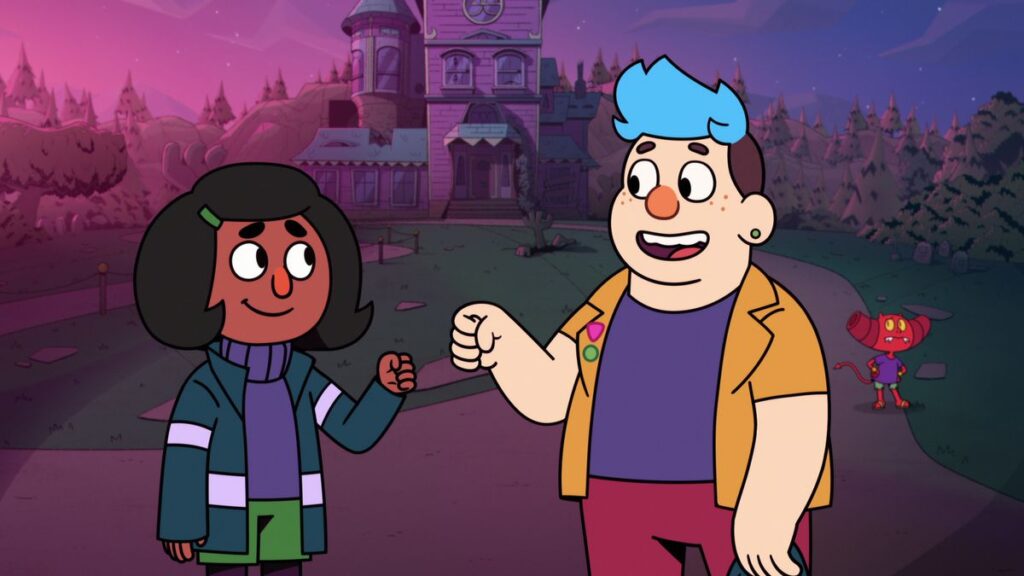Netflix’s Dead End: Paranormal Park is an animated adaptation of Hamish Steele’s DeadEndia graphic novel series, but the new show’s first season is also a shining example of the magic queer creators can work when given the resources and freedom to tell their own stories. Though Dead End’s tale about wayward teens finding themselves as they’re sucked into the paranormal happenings of a haunted theme park is distinctly its own, its existence is a testament to the impact that other recent progressively minded cartoons have had on modern animation.
Without shows like Steven Universe, She-Re and the Princesses of Power, and The Owl House, Netflix’s Dead End likely wouldn’t exist or be anywhere near as able to be the big-hearted, emotionally intelligent, all-ages romp that it is. The creative team behind Dead End knows this to be true, and they’re not afraid to show it in their work, which is just one of the reasons why the series feels like it’s going to be something worth getting invested in.
Much like the graphic novels — which themselves were inspired by Cartoon Hangover’s 2014 Dead End written by Steele — Netflix’s Dead End tells the story of Barney (Zach Barack), a shy but friendly teenager whose coming out as trans is part of what leads to him leaving his childhood home in search for a place where he feels like he truly belongs. While Barney’s family loves him, between the changes in his life and his uncertainty about whether they can accept him as he is, it feels easier for him to run away from his emotional demons than to confront them head-on, a trait many of Dead End’s main characters share.
Anxious hypochondriac Norma (Kody Kavitha) knows that her family only wants the best for her and that she could stand to work on her interpersonal skills, but it’s hard for her to open up to people outside of when she finds opportunities to talk about movie star Pauline Phoenix (Coco Peru). Though Pauline’s long dead as Dead End kicks off, her legacy lives on at a local theme park, and it’s a fateful job opening at the decidedly haunted attraction that first brings Norma, Barney, and his dog Pugsley (Alex Brightman) together just as their lives take an otherworldly turn.
In the world of Dead End, most dogs do not talk, but after Pugsley’s possessed during Barney and Norma’s joint visit to Phoenix Parks, he’s left with the ability to speak, and it only slightly alarms his human friends because it’s just one of the strange things that happens there. Long before Pugsley speaks, he and the others learn firsthand how Phoenix Parks is plagued with demons like the Hellboy-ish Courtney (Emily Osment) and hordes of rotting mascots ripped straight out of cheesy horror movies. After years of disturbing hauntings, barely anyone in town with sense wants anything to do with Phoenix Parks. But the presence of the supernatural is precisely what makes it a dream for Norma — a fan of horror movies — and Barney — someone dead set on living anywhere but under his parents’ roof.
Dead End introduces its players and lays out its premise within the first 15 minutes of its premiere 30-minute-long episode and quickly settles into a rhythm that falls somewhere between Disney’s Gravity Falls and Cartoon Network’s Foster’s Home For Imaginary Friends. Dead End’s opening scenes make clear that the show means to take its time as it carefully reveals new pieces of a larger, occasionally David Lynchian mystery about Pauline’s death as the season progresses. But each of Dead End’s 10 episodes also works as interconnected explorations of the feelings all young people deal with when they’re first setting off on their own.

Barney being trans is a major part of who he is and Dead End: Paranormal Park’s story, but the show’s queerness manifests itself more in moments of celebration of queer pop culture rather than in typical rehashings of traumatic queer narratives. When Dead End isn’t jokingly aping classics of the horror genre via the park, it’s spotlighting a drag icon through characters like Pauline and hammering home the idea that love and community are things people have to actually work at maintaining within their found families.
It’s impossible to ignore the irony of Dead End: Paranormal Park being a Netflix project or arriving at a time when the streamer’s decided to platform stories with hateful messages about queer people — trans people in particular. Simply by existing in all its queerness, Dead End illustrates the good that’s come from countless people pushing for animation to become more expansive and inclusive of LGBTQ stories and the people whose lived experiences inspire them.
It’s not that Dead End: Paranormal Park isn’t working hard to pull all of this off, but by this first season’s finale, you do get the sense that this isn’t even all that the show could be. Dead End: Paranormal Park has even more to offer if and when Netflix sees fit to renew it for another batch of episodes, and while it’s very much in the network’s hands, the decision it should make is obvious.
Dead End is now streaming on Netflix.

